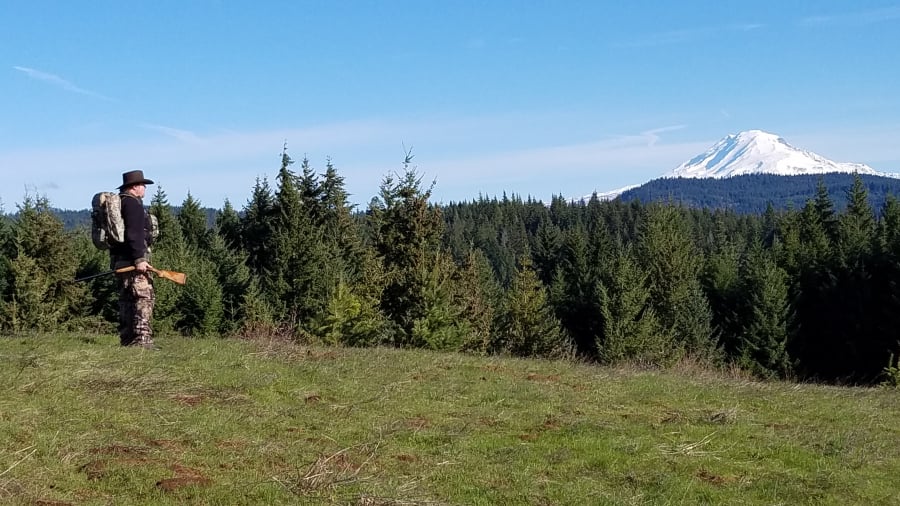Each time I called to the birds they would gobble right back, and each gobble sent electric excitement through me. I struggled to contain my excitement while I also struggled to get the receptive birds to move toward me. However, the Toms were “henned-up”.
Toms that still have hens in tow have no reason to go searching for more, and these birds, receptive though they were, were content with their harem.
We were about 70 yards from the flock, although the brushy understory prevented us from seeing them. We kept inching through the trees toward them, because sometimes you can get a Tom to come if you close the distance enough.
I slipped to the next tree, and called again.
Silence. Not a good sign. They had responded to each of my calls immediately so far. I wondered if they had spotted me during my last move.
Wild turkeys have incredibly sharp eyesight. My fears were confirmed when I heard the birds moving off through the woods.
I signaled to my hunting partner, Buzz Ramsey of Lyle, that the jig was up, and we backed off. The only good news was that the birds did not act spooked. They hadn’t bailed out hard, which they would have if they felt they were being hunted.
We accepted defeat for the day. After all, the season was six weeks long, and we would have another chance at these birds. Eventually the hens would go off to sit their nests, leaving the Toms lonely and looking for love.
I had pulled a young Tom out of this patch of national forest land in Klickitat County last year, and it seemed there were more birds around this year. We knew a few other hunters had found success from a couple shots we heard fired in the distance, and from a post or two sent to us via text.
We had worked hard and covered a lot of ground trying to find receptive birds this opening morning. We had heard a few gobbles, seen a few toms, and talked with a few turkeys before we stumbled on this active flock.
Turkey hunting season opened this last Monday, and it runs through May 31. In the spring, hunters try to lure the mating Toms into range with hen calls and decoys. It can be difficult because the natural thing for the males to do is strut and gobble to attract the hens to them.
Although, if you find the right bird at the right time, he will come right in to a hen call.
Turkey populations strong
Stephanie Bergh is the wildlife biologist for Washington Department of Fish and Wildlife District 9. While she reports that they do not survey the turkey population, harvest reports paint the picture of a healthy flock.
“Generally, in turkey season we harvest between 400 and 500 animals,” said Bergh. “Hunters harvested about 450 turkeys last year for a 32 percent success rate. There are lots of birds around, all over the place.”
She reported seeing plenty of turkeys on the Klickitat Wildlife Area in the Klickitat River Valley recently.
A warm spring last year meant good nesting conditions and good brood survival.
“It was warm and mild in May, and spring conditions are what affect the survival rate for them,” said Bergh. “They are such small chicks that if it is cold and rainy they don’t do well.”
“The harvest is really stable, and the success rate is really stable,” she added.
The turkey population centers on the Klickitat River Valley, which is loaded with good turkey habitat. In fact, there is almost too much good habitat.
“We have so much good turkey habitat that the turkeys don’t occupy it all,” said Susan Van Leuven, the manager of the Klickitat Wildlife Area.
She reports that when the birds feel pressured by hunters, they simply move elsewhere.
“If they think they need to move it is easy for them to move to a different spot,” she said. “They can do pretty well practically everywhere around here.”
The wildlife area is one of the most popular public spots to hunt turkey in Klickitat County, but how much hunting pressure is there?
“I wouldn’t say we have all that much pressure compared to deer season,” said Leuven. “But we always have good turnout for the opening of turkey season. There will be people out here.”
Van Leuven has some words of practical advice for hunters headed to the wildlife area this year: be cautious of the wildlife area’s roads.
“Sometimes in their enthusiasm hunters don’t exercise good judgement,” she said. “Some of these roads are not really improved. Let people know: driving off the road is not a good idea.”
As the season progresses more Tom turkeys will end up lonely and vulnerable, but they will also become hunter-wise. The birds are out there right now, searching for love. Play your cards right and you will fill that tag.
Hunters need a small game license and a turkey transport tag to hunt turkeys in Washington. Only bearded birds are legal in the spring. Check the regulations for complete information.




